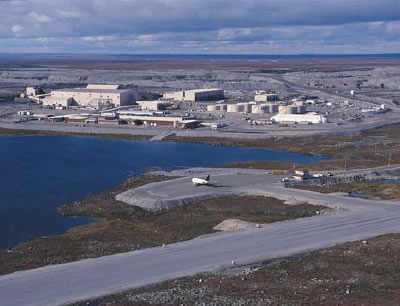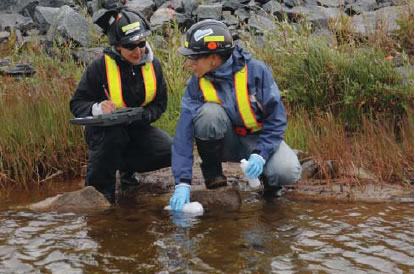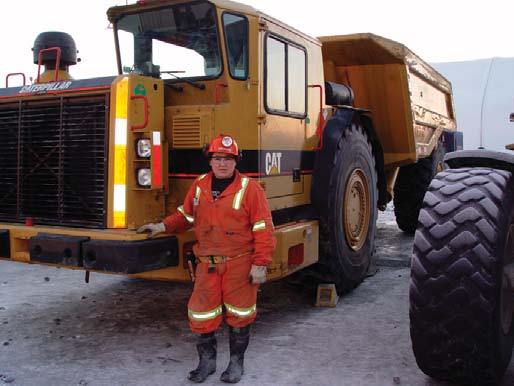ARCHIVED - Ekati Diamond Mine – Northwest Territories
Information Archived on the Web
Information identified as archived on the Web is for reference, research or recordkeeping purposes. It has not been altered or updated after the date of archiving. Web pages that are archived on the Web are not subject to the Government of Canada Web Standards. As per the Communications Policy of the Government of Canada, you can request alternate formats. Please "contact us" to request a format other than those available.
PDF version (318 kb)
PARTNERSHIP AGREEMENTS
The Minerals and Metals Sector of Natural Resources Canada promotes the participation of Aboriginal communities in minerals and metals activities across Canada by sharing information on Aboriginal-industry leading practices.
Project
The Ekati diamond mine, majority owned by BHP Billiton Diamonds Inc., is located approximately 300 km northwest of Yellowknife in the Northwest Territories. Since opening in 1998 as Canada's first underground and surface diamond mine, production has grown to reach an estimated 4% of the world's total diamond supply, or more than 4.5 million carats of rough diamonds per year. Although primarily a fly-in, fly-out operation, the mine can be reached by a 475-km ice road for up to three months each winter.

Signed Agreements
In 1996, BHP Billiton signed a socio-economic agreement with the Government of the Northwest Territories in which the company made a commitment to provide employment, training, and business opportunities for Aboriginal peoples. The mine operator signed four Impact and Benefits Agreements (IBAs) with regional Aboriginal communities, including the Dogrib Treaty 11 Council, the Akaitcho Treaty 8, the North Slave Metis Alliance, and the Inuit of Kugluktuk with the Kitikmeot Inuit Association. Although confidential, the agreements cover annual cash payments from the mine to communities, annual scholarship funds, preferential hiring and business opportunities for Aboriginal peoples, and environmental protection measures.
Employment and Training
The Ekati mine employs about 800 people on site with approximately 600 additional contractors providing support services. Of this number, 33% are Aboriginal, exceeding the company's target of 31% Aboriginal employment. Employees generally work two-week, 12-hour shifts at the mine, followed by two weeks out. Round-trip, work-related flights are provided to the mine from numerous Aboriginal and regional communities. Of the 123 positions filled by Aboriginal women at Ekati, 24% are considered non-traditional occupations. Named one of Canada's top 100 employers for five consecutive years, Ekati operates the Workplace Learning Program in an eff ort to build essential skills in the work force, including reading, writing, math, and oral communication. Participation in the program is voluntary and confidential, and work release time is provided to allow employee attendance. An Aboriginal Underground Miners Training Program has also been established to provide new opportunities for working underground, with six classes of graduates so far.
Economic/Business Development
Ekati's socio-economic agreement set a 70% spending target during operations for Aboriginal and northern-owned businesses. In 2006, the mine spent $326 million, or 78% of total spending, on Aboriginal and northern businesses; $123 million was spent on goods and services obtained from northern Aboriginal-owned businesses. This represents 29% of the total expenditures of $418 million. Aboriginal-owned businesses and joint ventures have secured numerous contracts at the mine, including contracts for mining services, explosives and blasting supply, catering, transportation services, janitorial services, and freight haulage services. Ekati assists Aboriginal suppliers attain joint-venture and business partnerships, attempts to tender IBA suppliers first, allows for the "unbundling" of large contracts so smaller businesses can compete, and provides opportunities for local suppliers to deliver goods and services that may only be available in the south. Contracts with Aboriginal businesses since 1999 have amounted to $847 million, representing 27% of total spending at the mine.

Social/Cultural and Community Support
The Ekati Diamond Mine Community Partnership Program provides financial and in-kind support to local communities for projects that promote safety, the environment, youth development, community arts and cultural activities, and social well-being. Employees also receive paid time off to volunteer at local charities. While at the mine itself, employees are housed in a 683-room accommodation complex with a dining room, kitchen, gymnasium, squash courts, exercise room, TV lounges, and his and her saunas. A company-subsidized social club organizes events at the mine, including a family day where families are flown to the mine for a full day of activities.
Environmental Protection
Environmental technicians and scientists at Ekati monitor airborne dust and emissions through the Air Quality Monitoring Program, and they monitor fish populations, microscopic water-borne animals and plants, stream flows, and water samples through the Aquatic Effects Monitoring Program. The company also monitors animals living on lands and in waters within the lease area through the Wildlife Effects Monitoring Program. In addition, it has funded studies aimed at integrating traditional knowledge of the region with the mine's environmental management practices. For example, the Ekati Caribou and Roads Traditional Knowledge Project adapted traditional Inuksuit hunting methods, such as building rock piles, to divert caribou away from roads and pits surrounding the mine.
Moving Forward
The Koala Underground Project, an expansion of the Ekati mine, was expected to deliver first ore for processing in late 2007. Its production life is expected to be 11 years, with Ekati pledging to enhance its level of Aboriginal participation during this time.

For more information on the Ekati diamond mine, please contact:
Tel.: 1-867-669-6100
Photos courtesy of BHP Billiton Diamonds Inc. (used with permission).
2008
For more information on Aboriginal communities and mining,
please visit www.nrcan-rncan.gc.ca/mms-smm or
send an e-mail to info-mms@nrcan-rncan.gc.ca
Page details
- Date modified: